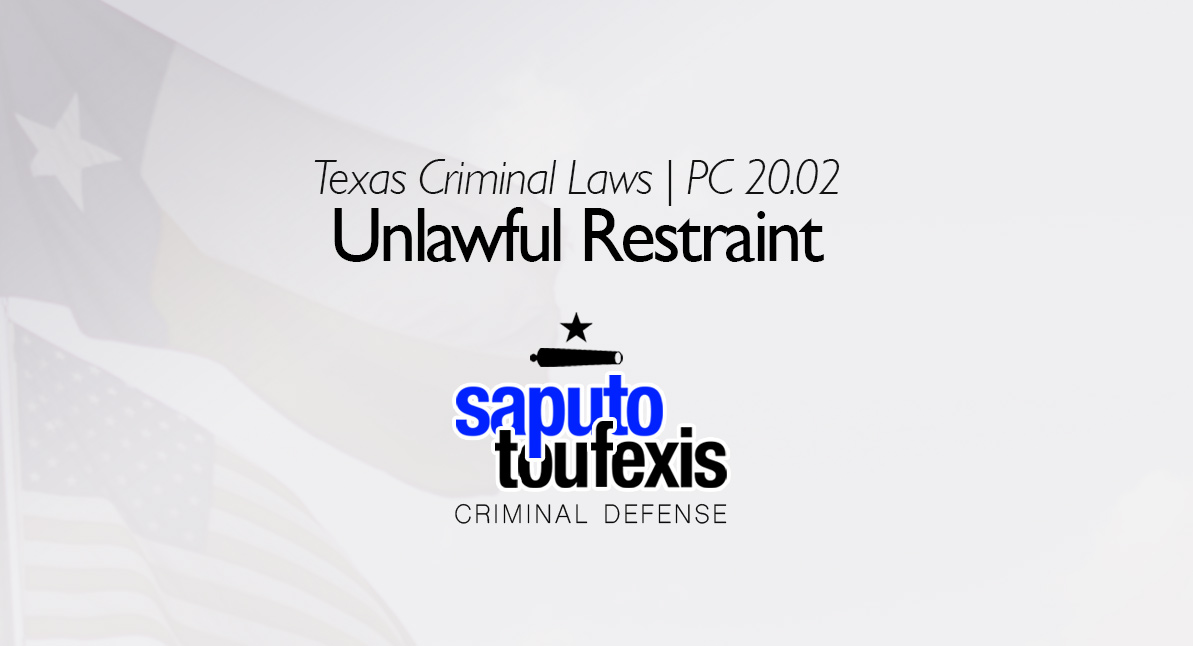The Texas Unlawful Restraint law is a criminal offense that makes it illegal to intentionally or knowingly restrain an individual, a business, or other group of people.
FAQs about the
Unlawful Restraint law in Texas
- What is the current Texas law about Unlawful Restraint?
- Can this law apply to a corporation, association, or limited liability company? What exactly does person mean under this statute?
- Are there any affirmative defenses?
- What exactly does it mean to “restrain” somebody?
- I did not know that the person was being restrained by me. Does that affect anything?
- What is the statute of limitation for Unlawful Restraint in Texas?
- What is the penalty for a Texas Unlawful Restraint offense?
- Can you get probation for Unlawful Restraint in Texas?
- Do I have to register as a sex offender in Texas if guilty of Unlawful Restraint?
- What level of crime is Unlawful Restraint in Texas?
Unlawful Restraint is the least serious kidnapping-type offense in the Texas Penal Code.
Have you been charged with Unlawful Restraint? Contact us today to discuss legal representation.
or Text or Call (888) 239-9305
The Texas legislature codified this criminal offense in Texas Penal Code Section 20.02. The legislature added a new felony enhancement to the Unlawful Restraint offense in 2017, and then again in 2023. The 2017 enhancement allowed the state to charge the offense as a second degree felony if the victim was a judge or a peace officer. The 2023 enhancement applied to people in civil commmitment facilities. These are explained more in the range of punishment section below.
The Unlawful Restraint law also exempts certain restraints related to “lawful arrests.” In addition, there are two affirmative defenses under the law, available only if the restrained person is under 18.
Below, we explain how Texas defines the offense of Unlawful Restraint, review the penalties for the offense, and explore some ways to defend against the charge. What Is Unlawful Restraint Texas?
The Penal Code classifies the Texas Unlawful Restraint law under Title 5 “Offenses Against The Person,” Chapter 20 “Kidnapping, Unlawful Restraint, and Smuggling of Persons.” Learn more about the Texas offense of Unlawful Restraint below.
What is the current Texas law about Unlawful Restraint?
Texas law currently defines the offense of Unlawful Restraint in Penal Code Section §20.02 as follows:[1]
(a) A person commits an offense if he intentionally or knowingly restrains another person.
Accordingly, anyone who intentionally or knowingly restrains another person commits the offense of Unlawful Restraint. The term “restrain” is a defined term, as is “person.”
The offense is typically a Class A misdemeanor offense, but it may be enhanced to a felony.
Can this law apply to a corporation, association, or limited liability company? What exactly does person mean under this statute?
Chapter 20 of the Texas Penal Code defines a “person” to mean not only an individual, but also a corporation, association, limited liability company, or other entity or organization governed by the Business Organizations Code.[2] So, conceivably, a corporation, LLC, or other association of people could be both a victim and a perpetrator of this offense.
Are there any affirmative defenses?
There are two sets of conditions that, if met you would have an affirmative defense. If you unlawfully restrained someone under subsection (a), but the circumstances were such that either one of the sets of conditions were met, your criminal defense attorney could assert an affirmative defense. The state’s attorneys would then have the “burden of proof” in a trial to show that the conditions were not true.
The first set of conditions is in Texas Penal Code Section 20.02(b):
(1) the person restrained was a child younger than 14 years of age;
(2) the actor was a relative of the child; and
(3) the actor’s sole intent was to assume lawful control of the child.
The second set of conditions is in Texas Penal Code Section 20.02(e):
(1) the person restrained was a child who is 14 years of age or older and younger than 17 years of age;
(2) the actor does not restrain the child by force, intimidation, or deception; and
(3) the actor is not more than three years older than the child.
What exactly does it mean to “restrain” somebody?
The term “restraint” is defined under Section 20.01(1) of the Texas Penal Code as “restrict[ing] a person’s movements without consent, so as to interfere substantially with the person’s liberty, by moving the person from one place to another or by confining the person.” This means that you do not have to physically touch someone in order to restrict their movements. Locking someone in a room would also be considered a restraint. In fact, physical action might not be necessary at all to restrict someone. For example, threatening to kill someone if they leave a room would be considered a restriction on their movement, even though it involves no physical action.
The statute also defines what it means to restrict without consent. According to Section 20.01(1):
Restraint is “without consent” if it is accomplished by:
(A) force, intimidation, or deception; or
(B) any means, including acquiescence of the victim, if:
(i) the victim is a child who is less than 14 years of age or an incompetent person and the parent, guardian, or person or institution acting in loco parentis has not acquiesced in the movement or confinement; or
(ii) the victim is a child who is 14 years of age or older and younger than 17 years of age, the victim is taken outside of the state and outside a 120-mile radius from the victim’s residence, and the parent, guardian, or person or institution acting in loco parentis has not acquiesced in the movement.
“In loco parentis” means to act in place of the parent.
I did not know that the person was being restrained by me. Does that affect anything?
While this specific statute does not state what kind of knowledge or intent was required to be charged, the Texas Penal Code defaults to a requirement that you were at least reckless to the risk of causing someone to be restrained.[3] This means that you must have been aware of the risk and disregarded it by your actions. For example, if you were to know there was a substantial risk of locking someone in a building when you were leaving, but you didn’t bother to check and locked when you left, you would be considered to have acted recklessly.
What is the statute of limitation for Unlawful Restraint in Texas?
Misdemeanor level Unlawful Restraint charges have a two-year limitations period.[4] Felony level offenses have a three-year limitations period.[5]
What is the penalty for a Texas Unlawful Restraint offense?
Unlawful Restraint is punished as a Class A misdemeanor unless the state can prove that one of the felony enhancements applied to the offense conduct.[6] If the state can prove that the the individual restrained was under the age of 17, Unlawful Restraint the offense is punished as a State Jail Felony if [7] The offense can be enhanced to a Third Degree Felony if any of the following conditions are met (bracketed language was added in 2023):[8]
- (A) the actor recklessly exposes the victim to a substantial risk of serious bodily injury;
- (B) the actor restrains an individual the actor knows is a public servant while the public servant is lawfully discharging an official duty or in retaliation or on account of an exercise of official power or performance of an official duty as a public servant; or
- (C) the actor[,] while in custody [or committed to a civil commitment facility,] restrains any other person.
How this law was amended in 2017
Effective September 1, 2017,[9] a new enhancement makes an Unlawful Restraint conviction a Second Degree Felony “if the actor restrains an individual the actor knows is a peace officer or judge while the officer or judge is lawfully discharging an official duty or in retaliation or on account of an exercise of official power or performance of an official duty as a peace officer or judge.”[10]
How this law was amended in 2023
The legislature expanded the third degree felony enhancement in subsection (c)(2)(C), effective September 1, 2023,[11] to include Unlawful Restraint by people who are committed to a civil commitment facility.[12]
Can you get probation for Unlawful Restraint in Texas?
The Texas Code of Criminal Procedure allows both judges and juries to grant probation for Unlawful Restraint, and judges are also allowed to accept deferred adjudication plea deals.[13]
Note, however, that no matter the offense, neither judges nor juries may recommend community supervision for any suspended sentence of over 10 years.[14] Also, judges may not grant community supervision after a conviction if (1) the defendant used or exhibited a deadly weapon during the commission of the felony or immediate flight thereafter and (2) the defendant used or exhibited the deadly weapon himself or was a party to the offense and knew that a deadly weapon would be used or exhibited.[15]
Do I have to register as a sex offender in Texas if guilty of Unlawful Restraint?
Any Texas Unlawful Restraint conviction or adjudication, including deferred adjudication, requires registration as a sex offender if the order in the hearing or the papers in the case contain an affirmative finding that the victim or intended victim was younger than 17 years of age.[16]
What level of crime is Unlawful Restraint in Texas?
The Penal Code classifies the punishment for Unlawful Restraint as a Class A misdemeanor, state jail felony, or third degree felony, depending on the circumstances.
Learn more about the penalty range for this offense in the section above.
Legal References:
^1. Texas Penal Code §20.02. This law is current as of 2024.^2. Texas Penal Code §20.01(4), as amended by SB 1258, 86th Texas Legislature (RS), Section 4^3. Texas Penal Code §6.02(c)^4. Code of Criminal Procedure 12.02(a)^5. See Code of Criminal Procedure 12.01(9)^6. Texas Penal Code §20.02(c)^7. Texas Penal Code §20.02(c)(1)^8. Texas Penal Code §20.02(c)(2), as amended by SB 1179, 88th Texas Legislature (RS), Section 1^9. HB 2908, 85th Texas Legislature (RS), Sections 6-7^10. Texas Penal Code §20.02(c)(3), effective September 1, 2017, enacted by HB 2908, 85th Texas Legislature (RS), Section 2^11. SB 1179, 88th Texas Legislature (RS), Section 32^12 SB 1179, 88th Texas Legislature (RS), Section 1^13. See Chapter 42, Texas Code of Criminal Procedure, Art. 42A.054, Art. 42A.056, Art. 42A.102^14. Art. 42A.053(c), Texas Code of Criminal Procedure^15. Art. 42A.054(b), Texas Code of Criminal Procedure^16. Code of Criminal Procedure, Article 62.001(5)(E)










